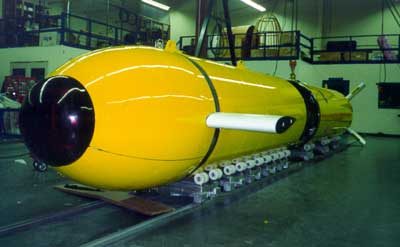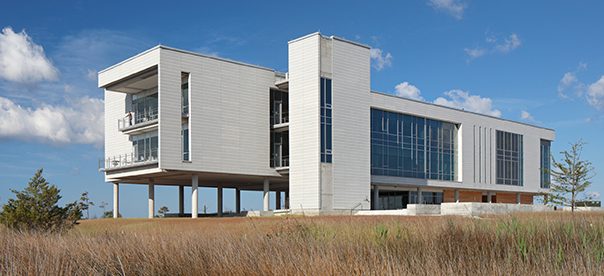First of two parts
WANCHESE – As the Gulf Stream passes Cape Hatteras, the movement of water is some 45 times greater than the flow of every river on earth. That amount of moving water represents an extraordinary amount of potential energy, enough energy, according to the Coastal Studies Institute, that harnessing just 0.1 percent of the available power would yield the equivalent of 150 nuclear power plants. That’s 300 gigawatts of power.
Supporter Spotlight

Cape Hatteras is the point at which the Gulf Stream passes closest to the continental United States – about 12 miles offshore. It is also the point at which the stream is most restricted, and therefore, most accessible. This two-part special report will explore the methods researchers are using to better understand the Gulf Stream’s power.
For the past four years, the Coastal Studies Institute’s North Carolina Renewable Ocean Energy Research Program has been studying the Gulf Stream, trying to determine if its power can be harnessed.
“What is the resource? Is it viable? How does it vary? Maybe we’ll find out that it’s not a viable resource,” said Mike Muglia, lead researcher for the program.
Although it is often described as a river within the Atlantic Ocean, that description falls short of what is happening.
The Gulf Stream is more like a fire hose that no one is holding; there is always flow and a lot of it, but the actual location of that flow is constantly changing.
Supporter Spotlight
The key to successfully harvesting the energy of the Gulf Stream is to always be where that flow is greatest.
University of North Carolina professor John Bane is an expert in wind and ocean current energy production and has been modeling the variability of the Gulf Stream.
Speaking at a recent CSI symposium on ocean energy Bane said, “This is one of the most important aspects in considering harvesting ocean energy from the Gulf Stream. The Gulf Stream is always there, but it’s not always in the same place.”
The modeling is getting better, and with the recent addition of the PEACH, or Processes driving Exchange at Cape Hatteras, a system launched in cooperation with the University of Georgia’s Skidaway Institute of Oceanography, the ability to predict where the best resource will be is improving.
“We are getting a much better handle on variability and the resource’s specific location from the information … and modeling we’ve gathered,” Muglia said.
With predictability of the resource improving, researchers are beginning to confront the next step.
“It probably is a viable resource,” Muglia said. “How are we going to get at it? How are we going to think about this?”
Some things are known.
Turbines would harvest the energy. Although there are design features of a water turbine that are different than wind turbines, the principals are the same.
What is different, and significantly, is how the turbines would be deployed.
A wind turbine is stationary. The blades move to the wind, but the platform on which it rests does not move.
The ocean is a three-dimensional environment. The Gulf Stream flows northward but within its stream, the strongest current is constantly moving east and west. There is also the possibility that useful amounts of energy can be harvested at varying depths.
“The Gulf Stream is variable in space. It is also variable in time,” explained Chris Vermillion, assistant professor of mechanical engineering at UNC-Charlotte. Vermillion was one of the presenters at the CSI Energy Symposium.
“There are some (other) challenges. One of the challenges is the Gulf Stream is a deep-water resource. It could be a couple of hundred meters (or about 650 feet) deep while the Gulf Stream is adjacent to North Carolina,” he added.
Although a turbine theoretically can harvest ocean energy from the Gulf Stream, it’s never been done. Florida Atlantic University in Boca Raton is also studying how to harness the energy of the Gulf Stream, although their focus differs from the Ocean Energy Program.
“They’ve focused more on … how you design a turbine and put it in the water and what does it do,” Muglia said.
The UNC team is focused on how that energy will be collected.
“We do have a side project that I’m collaborating on that is trying to figure out some unique way to put a turbine in the stream so that it can move,” Muglia said.
The turbine would have to be attached to a submersible – an autonomous underwater vehicle, or AUV, with the ability to move to the location of the best resource. The AUV would have two turbines attached to it, almost like propellers on an airplane wing.
There is an AUV that meets the criteria of the design team: the ISE Theseus that was developed for the Canadian Department of National Defense.
“It fits very nicely … to make this system work. You wouldn’t necessarily have to design that whole thing from scratch,” said Andre Mazzoleni, a member of the design team.
As the problem of harvesting energy underwater has been examined in detail, some things have become clear.
“It’s very unlikely a single turbine in isolation is economical. The likelier case is that turbines need to be installed in arrays. Because of the depths, it’s very unlikely a towered system is economical. The systems would have to be tethered to the ocean floor,” Muglia said. “The tether would not just be a part of the system that moves energy, but it also would be part of the system that moves information.”
The information that would be sent along the tether would tell the AUV where the best resource was located.
Any commercial harnessing of energy from the Gulf Stream is years in the future. Muglia points out, though, that the concept of energy from the ocean does not exist in isolation.

“The area that we’re working in the Gulf Stream is the only area that has been identified (by the Department of Energy) as a viable wave-energy resource on the East Coast,” he said.
There is also ongoing research at North Carolina State University to develop an ocean compressed air energy storage, or OCEAS, system. The system would use the pressure of ocean waters to compress air in storage. As the air is released it would turn a turbine, creating usable energy. Needing a minimum depth of more than 1,300 feet to operate, the requirements of an OCEAS system match the anchor depths of the tethers for the AUVs.
“You need storage, which is why compressed air research is going on,” Muglia said. “To make it economically viable, part of the thing is, you need to be able to store this energy and put it on the grid when the demand is high.”
“Part of (the) economy of scale comes from diversity,” he said. “If I’m going to go to the trouble of cabling the areas of the Gulf Stream, now I’ve got energy infrastructure in place. I truly think that if we do a project like this it’s not going to be Gulf Stream energy alone.
Learn More
Thursday: Using Radar to Measure Currents












